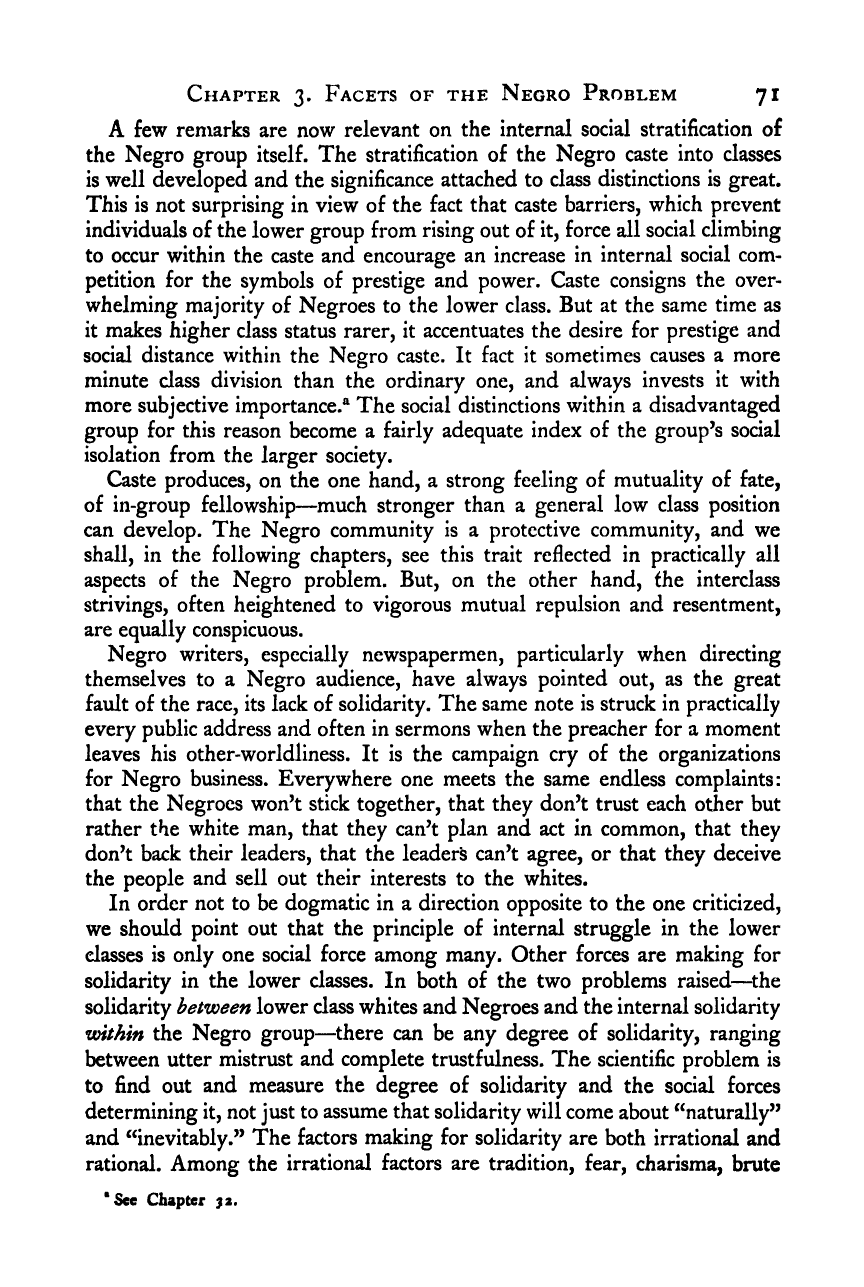Note: Gunnar Myrdal died in 1987, less than 70 years ago. Therefore, this work is protected by copyright, restricting your legal rights to reproduce it. However, you are welcome to view it on screen, as you do now. Read more about copyright.
Full resolution (TIFF) - On this page / på denna sida - I. The Approach - 3. Facets of the Negro Problem - 5. Relationships between Lower Class Groups

<< prev. page << föreg. sida << >> nästa sida >> next page >>
Below is the raw OCR text
from the above scanned image.
Do you see an error? Proofread the page now!
Här nedan syns maskintolkade texten från faksimilbilden ovan.
Ser du något fel? Korrekturläs sidan nu!
This page has never been proofread. / Denna sida har aldrig korrekturlästs.
Chapter 3. Facets of the Negro Problem 71
A few remarks are now relevant on the internal social stratification of
the Negro group itself. The stratification of the Negro caste into classes
is well developed and the significance attached to class distinctions is great.
This is not surprising in view of the fact that caste barriers, which prevent
individuals of the lower group from rising out of it, force all social climbing
to occur within the caste and encourage an increase in internal social com-
petition for the symbols of prestige and power. Caste consigns the over-
whelming majority of Negroes to the lower class. But at the same time as
it makes higher class status rarer, it accentuates the desire for prestige and
social distance within the Negro caste. It fact it sometimes causes a more
minute class division than the ordinary one, and always invests it with
more subjective importance.^ The social distinctions within a disadvantaged
group for this reason become a fairly adequate index of the group’s social
isolation from the larger society.
Caste produces, on the one hand, a strong feeling of mutuality of fate,
of in-group fellowship—much stronger than a general low class position
can develop. The Negro community is a protective community, and we
shall, in the following chapters, see this trait reflected in practically all
aspects of the Negro problem. But, on the other hand, the interclass
strivings, often heightened to vigorous mutual repulsion and resentment,
are equally conspicuous.
Negro writers, especially newspapermen, particularly when directing
themselves to a Negro audience, have always pointed out, as the great
fault of the race, its lack of solidarity. The same note is struck in practically
every public address and often in sermons when the preacher for a moment
leaves his other-worldliness. It is the campaign cry of the organizations
for Negro business. Everywhere one meets the same endless complaints:
that the Negroes won’t stick together, that they don’t trust each other but
rather the white man, that they can’t plan and act in common, that they
don’t back their leaders, that the leaders can’t agree, or that they deceive
the people and sell out their interests to the whites.
In order not to be dogmatic in a direction opposite to the one criticized,
we should point out that the principle of internal struggle in the lower
classes is only one social force among many. Other forces are making for
solidarity in the lower classes. In both of the two problems raised—^the
solidarity between lower class whites and Negroes and the internal solidarity
within the Negro group—there can be any degree of solidarity, ranging
between utter mistrust and complete trustfulness. The scientific problem is
to find out and measure the degree of solidarity and the social forces
determining it, not just to assume that solidarity will come about ^‘naturally”
and ‘inevitably.” The factors making for solidarity are both irrational and
rational. Among the irrational factors are tradition, fear, charisma, brute
*See Chapter ^2.
<< prev. page << föreg. sida << >> nästa sida >> next page >>